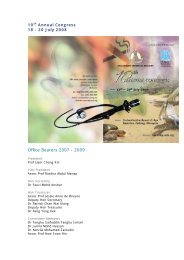download - Malaysian Thoracic Society
download - Malaysian Thoracic Society
download - Malaysian Thoracic Society
You also want an ePaper? Increase the reach of your titles
YUMPU automatically turns print PDFs into web optimized ePapers that Google loves.
Annual Congress of <strong>Malaysian</strong> <strong>Thoracic</strong> <strong>Society</strong><br />
Plenary Lecture 5<br />
Tuberculosis<br />
Updates on TB Laboratory Diagnostic Tools<br />
Ng Kee Peng<br />
Malaysia<br />
The care of patients with tuberculosis requires reliable and timely laboratory confirmation of infection. Although<br />
the landscape of new TB diagnostics is changing rapidly, the TB diagnostic algorithm remains basically the<br />
same, comprising a medical evaluation, chest radiograph, Mantoux tuberculin skin test, and appropriate<br />
laboratory tests including direct smear microscopy, culture, speciation and drug susceptibility testing.<br />
The TB diagnostic algorithm starts with the screening of specimens by direct microscopy. The current WHO<br />
policy on case finding by microscopy recommends that two sputum specimens be examined. The Ziehl-<br />
Neelsen (ZN) light microscopy is simple and inexpensive. It can be performed directly on sputum specimens<br />
and detects infectious cases of pulmonary TB. Conventional fluorescence microscopy is on average 10% more<br />
sensitive than ZN microscopy, but running cost is high and considerable technical expertise is required. Lightemitting<br />
diode (LED) fluorescent microscopy is cheaper and more efficient than conventional ZN microscopy.<br />
WHO has recommended conventional fluorescence microscopy to be replaced by LED microscopy and that<br />
LED microscopy is to be phased in as an alternative for conventional ZN light microscopy in both high- and<br />
low-volume laboratories.<br />
Mycobacterial culture using solid and liquid culture methods remain the gold standard of TB diagnostics. The<br />
BACTEC MGIT 960 automatic liquid culture system is used in most TB laboratories. It increases the case yield<br />
by 10% over solid media, and reduces the incubation time to 10 days to 2 weeks for a positive detection. LJ<br />
(Lowenstein-Jensen) solid culture is relatively cheap, it can be used for all types of clinical samples but the<br />
incubation time is 8 weeks.<br />
Positive cultures can be identified by Amplification Test (MTD), conventional biochemical tests, GenProbe<br />
Technology (AccuProbe), BD ProbeTec ET system, High Performance Liquid Chromatography (HPLC) and<br />
GenoType test systems from Hain Lifescience. As non-tuberculous mycobacteria (NTM) are more common in<br />
HIV-infected patients and the treatment of NTM infections is entirely different from the treatment of TB, it is<br />
important to implement a rapid method to identify and differentiate M. tuberculosis from other mycobacterial<br />
species. DST is essential for identifying patients at risk of MDR-TB, the automated liquid systems and<br />
molecular line probe assays are the current gold standard for first-line DST. Second-line DST is complex and<br />
expensive, requires laboratory infrastructure with rigorous quality assurance and sustainable proficiency<br />
plus high sample loads from high-risk patients per year.<br />
Fast track TB diagnosis offers rapid detection of TB in clinical specimens. GenoType MTBDR plus and Xpert MTB/<br />
RIF allow simultaneous identification of M. tuberculosis and resistance to rifampicin. GenoType Mycobacteria<br />
Direct allows the simultaneous detection of M. tuberculosis and NTM directly from decontaminated pulmonary<br />
and extrapulmonary clinical specimens except for blood..<br />
The Mantoux Tuberculin Skin Test detects a cell-mediated immune reaction to TB infection; the test may be<br />
negative in TB patients with an aberrant immune system. Interferon–Gamma Release Assays (IGRAs) are<br />
used to determine if a person has been infected with M. tuberculosis. The T-SPOT-TB and Quantiferon-TB<br />
Gold test are two blood tests available for the diagnosis of latent TB Infection.<br />
The scope of TB laboratory services depends on the infrastructure, facilities and workload of the laboratory.<br />
M. tuberculosis is classified as a Risk Group 3 pathogen, laboratory biosafety is important to prevent infection<br />
among laboratory personnel.<br />
38








